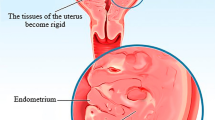Summary
Our normal values for magnesium, iron, zink, calcium and copper are corresponding with the results of other groups of authors. Following the application of ovulation inhibiting substances, the concentrations for the elements zink and calcium are decreasing, whereas the concentrations of copper, iron and magnesium are increasing. During pregnancy a decrease in concentration is observed in zink, iron, magnesium and calcium and an increase of concentration is observed concerning copper level. During pregnancy and during application of ovulation inhibiting steroids serum concentrations of iron and magnesium are behaving adversely. Only for zink a significant dependency of the concentration from the cycle phase could be found. In the normal menstrual cycle the highest zink concentrations were found during the time of ovulation. The variance of the results does, however, not permit to use the quoted concentrations as additional parameters for determining the gestational age. The values of all kations, however, may give relative information concerning the gestational age.
Zusammenfassung
Die von uns gefundenen Normalwerte für Magnesium, Eisen, Zink, Calcium und Kupfer stimmen mit entsprechenden Untersuchungen anderer Arbeitsgruppen überein. Bei Einnahme von Ovulationshemmern sinken die Konzentrationen für die Elemente Zink und Calcium ab, während sie bei Kupfer, Eisen und Magnesium ansteigen. In der Schwangerschaft kommt es zur Konzentrat ionsabnahme bei Zink, Eisen, Magnesium und Calcium und zu einer Konzentrationszunahme von Kupfer. Ein gegensätzliches Verhalten in der Schwangerschaft und unter Einnahme von Ovulationshemmern zeigen also die Serumkonzentrationen von Eisen und Magnesium. Eine deutliche Abhängigkeit der Konzentration vom Cyclusgeschehen ließ sich nur für Zink nachweisen. Im normalen Menstruationscyclus fanden sich zum Zeitpunkt der Ovulation die höchsten Zinkkonzentrationen. Zusätzliche Parameter zur Bestimmung des Gestationsalters ergeben sich wegen der Streubreite nicht. Immerhin können aus den Werten aller Kationen gewisse Aussagen bezüglich des Gestationsalters gemacht werden.
Similar content being viewed by others
Literatur
Benati, R.: Limportanza della ricerca della sideremia per una piu esatta valutazione della crasi sanguigna della gravida. Riv. Ostet. Ginec. prat.51, 135–147 (1969).
Borglin, N. E., Heijkenskjöld, F.: Studies on serum copper in pregnancy. Acta obstet. gynec. scand.46, 119–125 (1967).
Carruthers, M. E., Hobbs, C. B., Warren, L.: Raised serum copper and coeruplasmin levels in subjets taking oral contraceptives. J. clin. Path.19, 498 (1966).
Dawos, J. B., Heaton, F. W.: The determination of magnesium in biological materials by atomic absorption spectrophotometry. Biochem. J.80, 99–106 (1961).
Dokumov, S. I.: Serum copper pregnancy. Amer. J. Obstet. Gynec.101, 217 (1968).
Effkemann, G., Röttger, H.: Über den Kupferhaushalt während der Schwangerschaft. Klin. Wschr.28, 216 (1950).
Foley, B., Johnson, S. A., Hackley, B., Smith, J. C., Halsted, J. A.: Zinc content of human platelets. Proc. Soc. exp. Biol. (N. Y.)128, 265–269 (1968).
Goldsmith, N. F., Bamberger, J. P.: Mineral changes after norethynoldrel. Lancet1967 II, 567.
Hänze, S.: Der Magnesiumstoffwechsel, Physiologie und Klinik. Stuttgart: G. Thieme 1962.
Halsted, J. A., Hackley, B. M., Smith, J. C.: Plasma zinc and copper in pregnancy and after oral contraceptives. Lancet1968 II, 278.
Hellwege, H. H., Schmalfuß, H., Goschenhofer, D.: Mikrochemische Zinkbestimmung im Serum und Urin. Z. klin. Chem.7, 56–59 (1969).
Hunter, G.: Calcium and magnesium content of normal human blood serum. Nature (Lond.)182, 263–264 (1958).
Kaffarnik, H., Gassel, W. D., Lehnert, H., Schneider, J., Zöfel, P., Meyer-Bertenrath, J. G., Karsznia, R.: Befunde verschiedener Blutwerte unter Ovulationshemmern. Münch. med. Wschr.20, 757 (1971).
Krebs, H. A.: Über das Kupfer im menschlichen Blutserum. Klin. Wschr.7, 584 (1928).
Mardell, M., Zilva, J. F.: Effect of oral contraceptives on the variation in serum-iron during the menstrual cycle. Lancet1967 II, 1323–1325.
Maurat, J. P.: Le magnesium plasmatique. Dosage experimentale et clinique. These pour le doctorat en medicine (1957).
Methfessel, H. D., Mlytz, H., Methfessel, G., Löffler, F.: Das Verhalten von Kupfer und Eisen im Serum unter Wirkung des Ovulationshemmers Ovosiston. Z. ges inn. Med.19, 659 (1969).
Michel, C. F.: Der Serum-Magnesium-Spiegel während des Cyclus, in der Schwangerschaft und unter der Geburt. Ein Vergleich zum Serum-KalziumGehalt. Habilitationsschrift, Gießen 1964.
Michel, C. F.: Der Serum-Magnesium-Gehalt in der Schwangerschaft und unter der Geburt im Vergleich zum Serum-Kalzium. Z. Geburtsh. Gynäk.174, 276–285 (1971).
Mondorf, W., Kollmar, M., Halberstadt, E., Frey, J.: Untersuchungen über das Verhalten des Coeruloplasmins unter oralen Ovulationshemmern. Klin. Wschr.17, 958 (1968).
O'Learly, J. A., Spellacy, W. N.: Zinc and copper levels in pregnancy women and those taking oral contraceptives. Amer. J. Obstet. Gynec.103, 132 (1969).
Paschen, K., Fritz, G.: Neue vereinfachte Methoden zum empfindlichen und spezifischen Nachweis von Kalzium, Magnesium und Zink im Serum mit der Atomabsorptions-Spektralphotometrie. Ärztl. Forsch.7, 202–209 (1970).
Pfordte, K., Ponsold, W.: Beitrag zur Analytik des Kalziums im Blutserum (Methoden und Ergebnisse der Bestimmung von diffusiblem Kalzium). Z. ges. exp. Med.144, 31–38 (1967).
Russ, E. M., Raymunt, J.: Influence of estrogens on total serum copper and coeruloplasmin. Proc. Soc. exp. Biol. (N. Y.)92, 465 (1956).
Schenker, J. G., Jungreis, E., Polishuk, W. Z.: Serum copper levels in normal and pathologic pregnancies. Amer. J. Obst. Gynec.6, 933 (1969).
Schenker, J. G., Hellerstein, S., Jungreis, E., Polishuk, W. Z.: Serum copper and zinc levels in patients taking oral contraceptives. Fertil. and Steril.22, 229 (1971).
Stewart, W. K., Hutchinson, F., Fleming, L. W.: The estimation of magnesium in serum and urine by atomic absorption spectrometry. J. Lab. clin. Med.61, 858–872 (1963).
Strik, W. O., Haug, H.: Der Einfluß von Ovulationshemmern auf den Kupferspiegel des Serum. Klin. Wschr.17, 957–958 (1968).
Studnitz, W. von, Berezin, D.: Studies on serum copper during pregnancy, during the menstrual cycle and after the administration of estrogen. Acta endocr. (Kbh.)27, 245 (1958).
Wacker, W. E. C., Iida, C., Fuwa, K.: Accurary of determinations of serum magnesium by flame emission and atomic absorption spectrometry. Nature (Lond.)202, 659–661 (1964).
Wilbert, L., Hiller, T., Hunstein, W., Reisert, P., Kaboth, U., Creutzfeldt, W.: Einfluß oraler Ovulationshemmer auf klinisch-chemische Normalwerte. Dtsch. med. Wschr.94, 1 (1969).
Author information
Authors and Affiliations
Rights and permissions
About this article
Cite this article
Hähn, N., Paschen, K. & Haller, J. Das Verhalten von Kupfer, Eisen, Magnesium, Calcium und Zink bei Frauen mit normalem Menstruationscyclus, unter Einnahme von Ovulationshemmern und in der Gravidität. Arch. Gynak. 213, 176–186 (1972). https://doi.org/10.1007/BF00667673
Received:
Issue Date:
DOI: https://doi.org/10.1007/BF00667673



